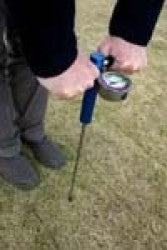Compaction - it's a hard one to crack
COMPACTION - IT'S A HARD ONE TO CRACK!
Compaction is considered be one of the major causes of poor sward density and root development. All this is due to the heavy use of machinery and thousands of unsympathetic feet tramping over sports turf day in, day out. We've all got compaction, but, do we know how bad it is?
SOIL COMPACTION
Soil is made up of soil particles either mineral or organic. These particles have spaces in between called pore spaces and they contain air and water in varying degrees depending on soil type and conditions. The ratio of pore space to particle would ideally be 50:50 in natural uncompacted friable soils. In soils supporting sports turf and subject to heavy continuous play, the story is very different of course.
Regular use of mowers and other machinery, combined with all that footwear plays havoc with the soil structure and in particular, the rootzone of our turf.
The continuous surface pressure, especially in wet unfavourable conditions inevitably results in the condition known as compaction. Compaction is progressive, starting at the surface, it builds progressively throughout the soil profile often to considerable depths, squeezing out pore space and the vitalingredients of air and water on which plant roots depend for survival. Without water movement and uptake, plants are starved of all available nutrients and when air occupies less than 10 - 15% of the total soil volume micro-organisms are depleted, resulting in poor aeration, restricted root growth and inhibited plant development.
Research in the USA has shown that soils compacted to levels measuring over 300psi can be expected to have poor root development. However, it is not unusual to find compaction levels of 600-800psi on UK sports turf including golf greens!

The Quakemeter is used by pushing its pointed tip into the soil and pressure is thus applied via the measuring rod to the hydraulic piston within the pressure chamber. This provides an accurate pressure reading on the gauge in Bar and psi. To make life easier Imants have even included coloured bands on the gauge for quick reference in green, yellow and red.
The green zone 0 -200psi (14 Bar) indicates acceptable un-compacted levels.
The yellow zone 200-300psi (21 Bar) indicates suspect levels of compaction for most healthy plants.
The red zone 300psi plus (21bar plus) shows unacceptable compaction levels for good root growth and development.
The Quakemeter comes with a comprehensive set of instructions and excellent hints and tips on measuring compaction levels on your sports turf. It has a guarantee against faulty workmanship and materials for 1 year. This superb and beautifully engineered instrument is another high quality tool from the Imants stable and retails at a very reasonable £179.00 + VAT plus postage and packing.
To get your hands on a Quakemeter call the Imants UK distributor Hortec Ltd. Hortec Ltd, Orchard Farm, Lower Tysoe, Warks
Tel: 01295 688422 Fax: 01295688455 Tom Jones Mobile: 07813 969025
All Press & Photographic enquiries to : Phil Evans Mktg/PR Group on 07752 795350.
